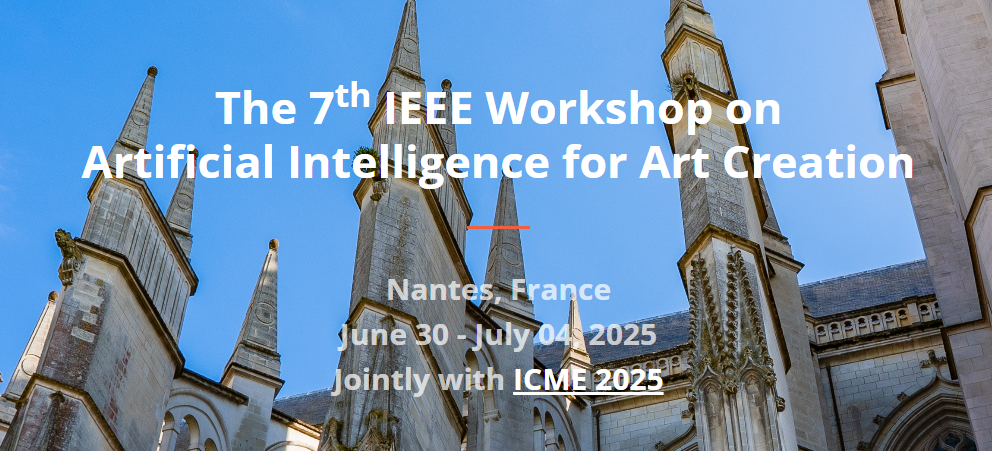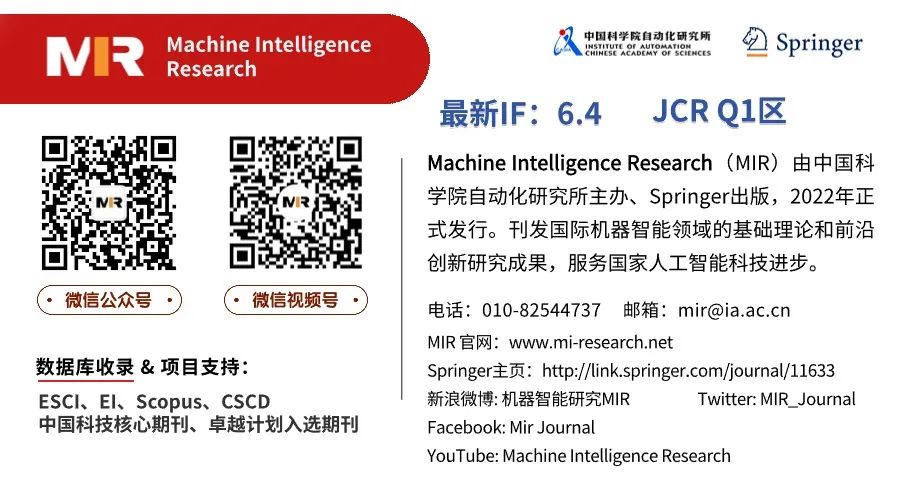今年7月,由MIR参与合作举办的学术会议AIART 2025将在法国召开(与ICME 2025同期),Workshop现公开征稿中,并诚邀赞助!

Recent advances brought by AI-Generated Content (AIGC) have been an innovative engine for digital content generation, drawing more and more attention from both academia and industry. Across creative fields, AI has sparked new genres and experimentations in painting, music, film, storytelling, fashion and design. Researchers explore the concept of co-creation with AI systems as well as the ethical implications of AI generated images and texts. AI has been applied to art historical research and media studies. The aesthetic value of AI generated content and AI’s impact on art appreciation have also been a contended subject in recent scholarship. AI has not only exhibited creative potential, but also stimulated research from diverse perspectives of neuroscience, cognitive science, psychology, literature, art history, media and communication studies. Despite all these promising features of AI for Art, we still have to face the many challenges such as the biases in AI models, lack of transparency and explainability in algorithms, and copyright issues of training data and AI art works.
This is the 7th AIART workshop to be held in conjunction with ICME 2025 in Nantes, France, and it aims to bring forward cutting-edge technologies and most recent advances in the area of AI art as well as perspectives from neuroscience, cognitive science, psychology, literature, art history, media and communication studies.
The theme topic of AIART 2025 will be AI and Human Co-creativity. We plan to invite 5 keynote speakers to present their insightful perspectives on AI art.
The authors of selected high-quality papers will be invited to submit an extended version to the Machine Intelligence Research (MIR) journal published by Springer.
Additionally, Best Paper Award will be given.
AIART 2025 is also launching a demo track for artists to showcase their creative artworks in the form of in-person art gallery. The demo track will provide a great opportunity for people to experience interactive artworks and communicate creative ideas. The submission guideline for the demo track follows that of the main ICME conference: https://2025.ieeeicme.org/author-information-and-submission-instructions/.
We sincerely invite high-quality papers presenting or addressing issues related to AI art, including but not limited to the following topics:
1) Affective computing for AI Art
2) AI in media studies
3) AI, literature, and art
4) AI and social justice
5) Theory and practice of AI creativity
6) Neuroscience, cognitive science and psychology for AI Art
7) AI Art for metaverse
8) AI for painting generation
9) AI for 3D content generation
10) AI for cultural heritage
11) AI for sound synthesis, music composition, performance, and instrument design
12) AI for poem composing and synthesis
13) AI for typography and graphic design
14) AI for fashion, makeup, and virtual hosting
15) AI for multimodal and cross-modal art generation
16) AI for art style transfer
17) AI for aesthetics understanding, analysis, assessment and prediction
18) Authentication and copyright issues of AI artworks
Authors should prepare their manuscript according to the Guide for Authors of ICME available at Author Information and Submission Instructions:
https://2025.ieeeicme.org/author-information-and-submission-instructions/
Submission address:
https://cmt3.research.microsoft.com/ICMEW2025
Submissions due:March 25, 2025
Workshop date:TBD
(滑动右侧进度条查看完整名单)
Ajay Kapur, California Institute of the Arts, USA
Alan Chamberlain, University of Nottingham, UK
Alexander Lerch, Georgia Institute of Technology, USA
Alexander Pantelyat, Johns Hopkins University, USA
Bahareh Nakisa, Deakin University, Australia
Baoqiang Han, China Conservatory of Music, China
Baoyang Chen, Central Academy of Fine Arts, China
Bing Li, King Abdullah University of Science and Technology, Saudi Arabia
Björn W. Schuller, Imperial College London, UK
Bob Sturm, KTH Royal Institute of Technology, Sweden
Borou Yu, Harvard University, USA
Brian C. Lovell, The University of Queensland, Australia
Carlos Castellanos, Rochester Institute of Technology, USA
Changsheng Xu, Institute of Automation, Chinese Academy of Sciences, China
Chunning Guo, Renmin University, China
Cong Jin, China University of Communication, China
Dong Liu, University of Science and Technology of China, China
Dongmei Jiang, Northwestern Polytechnical University, China
Emma Young, BBC, UK
Gus Xia, New York University Shanghai, China & Mohamed bin Zayed University of Artificial Intelligence, United Arab Emirates
Haifeng Li, Harbin Institute of Technology, China
Haipeng Mi, Tsinghua University, China
Han Zhang, University of Chinese Academy of Sciences, China
Hanli Wang, Tongji University, China
Haonan Chen, China University of Communication, China
Honghai Liu, Harbin Institute of Technology, China
Hongxun Yao, Harbin Institute of Technology, China
Jesse Engel, Google, USA
Jiafeng Liu, Central Conservatory of Music, China
Jia Jia, Tsinghua University, China
Jiajian Min, Harvard University, USA
Jian Zhang, Peking University, China
Jian Zhao, China Telecom, China
Jianyu Fan, Microsoft, Canada
Jing Huo, Nanjing University, China
Jing Wang, Beijing Institute of Technology, China
Jingjing Chen, Fudan University, China
Jingting Li, Institute of Psychology of the Chinese Academy of Sciences, China
Jingyuan Yang, Shenzhen University, China
Jinshan Pan, Nanjing University of Science and Technology, China
Joanna Zylinska, King’s College London, UK
John See, Multimedia University, Malaysia
Juan Huang, Johns Hopkins University, USA
Jufeng Yang, Nankai University, China
Junping Zhang, Fudan University, China
Kang Zhang, Hong Kong University of Science and Technology (Guangzhou), China
Kate Crawford, University of Southern California, USA
Ke Lv, University of Chinese Academy of Sciences, China
Kenneth Fields, Central Conservatory of Music, China
Lai-Kuan Wong, Multimedia University, Malaysia
Lamberto Coccioli, Royal Birmingham Conservatoire, UK
Lamtharn Hanoi Hantrakul, ByteDance, USA
Lei Xie, Northwestern Polytechnical University, China
Leida Li, Xidian University, China
Li Liu, Hong Kong University of Science and Technology (Guangzhou), China
Li Song, Shanghai Jiao Tong University, China
Li Zhou, China University of Geosciences (Wuhan), China
Lianli Gao, University of Electronic Science and Technology of China, China
Lin Gan, Tianjin University, China
Long Ye, China University of Communication, China
Mei Han, Ping An Technology Art institute, USA
Mengjie Qi, China Conservatory of Music, China
Mengshi Qi, Beijing University of Posts and Telecommunications, China
Mengyao Zhu, Huawei Technologies Co., Ltd, China
Ming Zhang, Nanjing Art College, China
Mohammad Naim Rastgoo, Queensland University of Technology, Australia
Na Qi, Beijing University of Technology, China
Nancy Katherine Hayles, University of California Los Angeles, USA
Nick Bryan-Kinns, Queen Mary University of London, UK
Nina Kraus, Northwestern University, USA
Pengtao Xie, University of California, San Diego, USA
Pengyun Li, Wuhan Conservatory of Music, China
Philippe Pasquier, Simon Fraser University, Canada
Qi Mao, China University of Communication, China
Qin Jin, Renmin University, China
Qiuqiang Kong, The Chinese University of Hong Kong, China
Rebecca Fiebrink, University of the Arts London, UK
Rick Taube, University of Illinois at Urbana-Champaign, USA
Roger Dannenberg, Carnegie Mellon University, USA
Rongfeng Li, Beijing University of Posts and Telecommunications, China
Rui Wang, Institute of Information Engineering, Chinese Academy of Sciences, China
Ruihua Song, Renmin University, China
Sarah Wolozin, Massachusetts Institute of Technology, USA
Shangfei Wang, University of Science and Technology of China, China
Shasha Mao, Xidian University, China
Shen Li, Henan University, China
Shiguang Shan, Institute of Computing Technology, Chinese Academy of Sciences, China
Shiqi Wang, City University of Hong Kong, China
Shiqing Zhang, Taizhou University, China
Shuai Yang, Peking University, China
Shun Kuremoto, Uchida Yoko Co.,Ltd, Japan
Si Liu, Beihang University, China
Sicheng Zhao, Tsinghua University, China
Simon Colton, Queen Mary University of London, UK
Simon Lui, Huawei Technologies Co., Ltd, China
Siwei Ma, Peking University, China
Steve DiPaola, Simon Fraser University, Canada
Tiange Zhou, NetEase Cloud Music, China
Wei Chen, Zhejiang University, China
Weibei Dou, Tsinghua University, China
Weiming Dong, Institute of Automation, Chinese Academy of Sciences, China
Wei-Ta Chu, National Chung Cheng University, Taiwan, China
Wei Li, Fudan University, China
Weiwei Zhang, Dalian Maritime University, China
Wei Zhong, China University of Communication, China
Wen-Huang Cheng, National Chiao Tung University, Taiwan, China
Wenli Zhang, Beijing University of Technology, China
Wenming Zheng, Southeast University, China
Xi Shao, Nanjing University of Posts and Telecommunications, China
Xi Yang, Beijing Academy of Artificial Intelligence, China
Xiaohong Liu, Shanghai Jiao Tong University, China
Xiaohua Sun, Tongji University, China
Xiaolin Hu, Tsinghua University, China
Xiaojing Liang, NetEase Cloud Music, China
Xiaopeng Hong, Harbin Institute of Technology, China
Xiaoyan Sun, University of Science and Technology of China, China
Xiaoying Zhang, China Rehabilitation Research Center, China
Xihong Wu, Peking University, China
Xin Jin, Beijing Electronic Science and Technology Institute, China
Xinfeng Zhang, University of Chinese Academy of Sciences, China
Xinyuan Cai, Huazhong University of Science and Technology, China
Xu Tan, Microsoft Research Asia, China
Ya Li, Beijing University of Posts and Telecommunications, China
Yan Yan, Xiamen University, China
Yanchao Bi, Beijing Normal University, China
Yi Jin, Beijing Jiaotong University, China
Yi Qin, Shanghai Conservatory of Music, China
Ying-Qing Xu, Tsinghua University, China
Yirui Wu, Hohai University, China
Yuan Yao, Beijing Jiaotong University, China
Yuanchun Xu, Xiaoice, China
Yuanyuan Liu, China University of Geosciences (Wuhan), China
Yuanyuan Pu, Yunnan University, China
Yun Wang, Beihang University, China
Zhaoxin Yu, Shangdong University of Arts, China
Zheng Lian, Institute of Automation of the Chinese Academy of Sciences, China
Zhi Jin, Sun Yat-Sen University, China
Zhiyao Duan, University of Rochester, USA
Zichun Guo, Beijing University of Chemical Technology, China
Zijin Li, Central Conservatory of Music, China

Luntian Mou
Beijing University of Technology
Beijing, China
ltmou@bjut.edu.cn

Feng Gao
Peking University
Beijing, China
gaof@pku.edu.cn

Kejun Zhang
Zhejiang University
Hangzhou, China
zhangkejun@zju.edu.cn

Zeyu Wang
Hong Kong University of Science and
Technology (Guangzhou)
Guangzhou, China
zeyuwang@ust.hk

Gerui Wang
Stanford University
California, USA
grwang@stanford.edu

Ling Fan
Tezign.com
Tongji University Design Artificial Intelligence Lab
Shanghai, China
lfan@tongji.edu.cn

Nick Bryan-Kinns
University of the Arts London
London, UK
n.bryankinns@arts.ac.uk

Ambarish Natu
Australian Government
Australian Capital Territory, Australia
ambarish.natu@gmail.com
Machine Intelligence Research, published by Springer, and sponsored by Institute of Automation, Chinese Academy of Sciences, is formally released in 2022. The journal publishes high-quality papers on original theoretical and experimental research, targets special issues on emerging topics and specific subjects, and strives to bridge the gap between theoretical research and practical applications. The journal has been indexed by ESCI, EI, Scopus, CSCD, etc.
Impact Factor=6.4, JCR Q1
MIR official websites:
https://www.springer.com/journal/11633
MIR Editor-in-Chief :
Tan Tieniu, Institute of Automation, Chinese Academy of Sciences
MIR Associate Editors-in-Chief:
Liang Wang, Chinese Academy of Sciences, China
Yike Guo, Hong Kong University of Science and Technology, China
Brian C. Lovell, The University of Queensland, Australia
MIR为所有读者提供免费寄送纸刊服务,如您对本篇文章感兴趣,请点击下方链接填写收件地址,编辑部将尽快为您免费寄送纸版全文!
说明:如遇特殊原因无法寄达的,将推迟邮寄时间,咨询电话010-82544737
收件信息登记:
https://www.wjx.cn/vm/eIyIAAI.aspx#
关于Machine Intelligence Research
Machine Intelligence Research(简称MIR,原刊名International Journal of Automation and Computing)由中国科学院自动化研究所主办,于2022年正式出版。MIR立足国内、面向全球,着眼于服务国家战略需求,刊发机器智能领域最新原创研究性论文、综述、评论等,全面报道国际机器智能领域的基础理论和前沿创新研究成果,促进国际学术交流与学科发展,服务国家人工智能科技进步。期刊入选"中国科技期刊卓越行动计划",已被ESCI、EI、Scopus、中国科技核心期刊、CSCD等20余家国际数据库收录,入选图像图形领域期刊分级目录-T2级知名期刊。2022年首个CiteScore分值在计算机科学、工程、数学三大领域的八个子方向排名均跻身Q1区,最佳排名挺进Top 4%,2023年CiteScore分值继续跻身Q1区。2024年获得首个影响因子(IF) 6.4,位列人工智能及自动化&控制系统两个领域JCR Q1区。

内容中包含的图片若涉及版权问题,请及时与我们联系删除




评论
沙发等你来抢